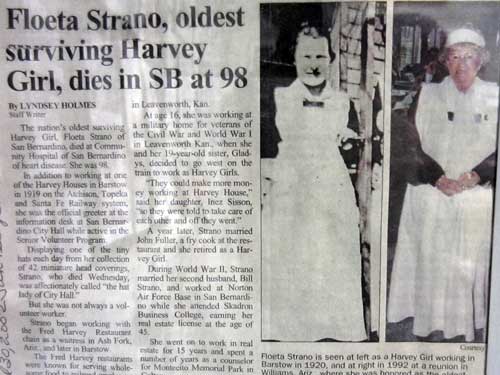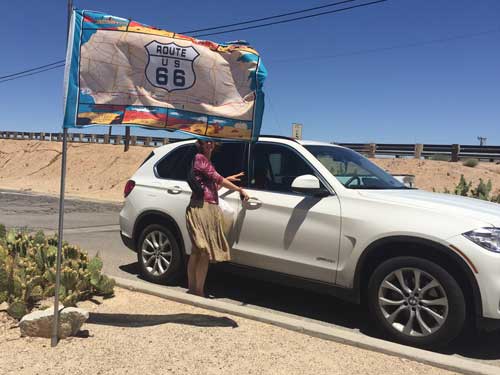LAS VEGAS (Day 12 - part 1)
We left all that is southern California and headed out towards Nevada... back over Cajon Pass, through Victorville, to Barstow.

Smog veils the San Gabriel Mountains.

Cajon Pass


Covered parking spaces by the Walmart in Victorville hint that desert temperatures must be a regular way of life out here.

At least they are attempting to battle the smog.
We stopped in Barstow to visit a couple interesting sites, the first of which was an old Harvey House.


The Barstow train depot and old Harvey House



On the right side of the tracks!

We had already learned a little bit about Harvey Houses back in the Petrified Forest since the Painted Desert Inn was one.
Fred Harvey was born in London in 1835. He immigrated to the States in 1850 and worked in restaurants in New York, New Orleans and St. Louis. In 1965 he went to work in Kansas for the railroad as a ticket agent then as a freight agent. His job required him to travel and quickly he recognized a deplorable lack of decent meals and lodging for railroad travelers.
The first Harvey House was opened in Topeka in 1876. In 1893 he had began taking over operation of all the depot hotel and restaurants along the Santa Fe railway line, including this location. Known as Casa Del Desierto, this was one of the largest. There was even a two-lane bowing alley, tennis court, pool and an ice house that produced 30 gallons of ice cream a day. It was designed by his head architect and interior designer, Mary Jane Colter and opened in 1911.

Frederick H. Harvey (1835 - 1901)

This is the forth building since the previous three burned. It was designed in the Spanish-Morrish style.

Signing the guest book at Harvey House #892

Fred Harvey found his male employees often unsatisfactory so he decided to exclusively hire women... who became known as the Harvey Girls. They ranged in age from 16 to 31. Mainly from the midwest, they were trained to be excellent waitresses. They had to sign a work contract ranging from 6 to 18 months and received $17.50 per month plus room and board. Furthermore, they:
- must be single the length of the contract
- must live in the dorm on site
- must have a manicure once a week
- must obey a 10 pm curfew
- must not wear any makeup or jewelry
- must wear a hair net
- must be courteous to but never talk to the patrons
When a train arrived, the girls had to serve up to 120 people every 20 minutes before the train left again. It is estimated that 5,000 girls found their husbands this way.

Now...

... and then.

The hand-pounded copper fixtures are original... although back then they were gas.


One of the original blue willow pattern plates. It is believed the Harvey House originated the "blue-plate special" (a daily low-priced meal) because of these plates. They are mentioned as far back as an 1892 menu.

A few of the more interesting menu items:
Baked barracuda, sauce Portuguese... $1.35
Roast leg of lamb au jus, mint jelly... $2.00
Shirred eggs with fresh shrimps a la Newburg, with a side order of succotash... $1.25
A cup of chicken consomme... 25 cents
A side order of marinated herring... 75 cents
A smoked liver sausage sandwich.... 65 cents
A broiled half chicken (allow 15 minutes) broiled a golden brown on whole wheat toast and then Chef Sogno adds a magic touch you will remember, mashed browned potatoes... $1.80
Shrimp (the jumbos size) superbly breaded and deep fried just right, tangy cocktail sauce, french fried potatoes and a cole slaw that is different... $1.70

Cheesecake was only 25 cents, pies and cakes ranged from 20 to 30 cents, and fresh strawberries with cream was 50 cents. Coffee ran you a dime.
In a back section of the building was the Route 66 Mother Road Museum. It was absolutely packed with cars, motorcycles, an old carriage, info, maps, photos, signs, trinkets, memorabilia... wonderful history pertaining to the highway and surrounding area... in all shapes and forms. The museum was opened on July 4, 2000.

A classic cruiser...

... although I'd never heard of a 1/2 year before!

Yum! Bob's Big Boy restaurant!

A 1915 4-cylinder Fort Model T touring car, originally priced at $490.



A Harley-Davidson 1947 Servi-car, used by the Barstow Police Department primarily for parking enforcement along Main Street... until the parking meters were removed some 20 years later.
Route 66 technically began in 1857 as a wagon road by the U.S. War Department. In 1924, a trip from Barstow to Las Vegas (which takes 2 hours 15 minutes today) took 18 hours straight. Reportedly, no other cars were passed. The U.S. Highway System was created in 1925 to connect rural communities that had no prior access to a major national thoroughfare. Route 66 would stretch from Chicago, Illinois, to Santa Monica, California.
In the mid-1930's, many people fled Kansas and the neighboring states to escape the Dust Bowl (a large area of the Midwest damaged by horrible dust storms). Route 66 was the only way to California. But back then, only 800 miles were paved. The remaining 1,648 miles were graded dirt or gravel, asphalt-covered bricks or wooden plants. Unexpected dips, curves and hills caused many fatal collisions. The road through Oatman was supposedly terrifying... with sharp curves perched along deep ravines. Cars overheated, brakes failed and charred remains of loaded trucks were visible in the brush.

A difficult and treacherous road
Route 66 helped move enormous amounts of resources during WWII. It was not uncommon to see mile-long convoys transporting men, defense-related materials and other vital supplies. Since many items were rationed included sugar, meat, coffee, typewriters, fuel oil, gasoline, rubber and cars, pleasure driving was prohibited and no new cars were made from 1942 - 46.
After the war, people were more mobile than ever and looking to relocate. "Get your kicks on Route 66." California got over 3 million new residents in the 1960's and another 2 million in the 1970's. All along the route were new stores, motels (a new term back then meaning "motor hotel"... basically a hotel specifically designed for motorists with a large, convenient parking area), diners, gas stations and other travel related businesses.
Unfortunately, due to the great use, the roads deteriorated to a horrible condition. They were also too narrow, had limited carrying capacity and most of the bridges were made of wood. Automobile production jumped form 65,000 cars in 1945 to 3.9 million in 1948. So in 1956, the federal highway system was create by the Interstate Highway Act. President Dwight D. Eisenhower felt that more direct routes were a necessary component of a national defense system. Gradually parts of the once-great highway began to be upgraded or bypassed. By 1970, the final pieces of Route 66 were replaced and it was eventually officially eliminated from the United States Highway System... although some sections still have signs saying "Old Route 66." It may be erased from the maps, but it will never be erased from our hearts.


Tips on getting more efficient work out of women employees, from Transportation Magazine...
- Pick young married women. They're likely to be less flirtatious and they need the work or they wouldn't be doing it. When you have to use older women, try to get ones who have worked outside the home at some point in their lives. Older women who have never contacted the public are inclined to be cantankerous and fussy.
- "Husky" girls are more even tempered and efficient than their underweight sisters.
- Retain a physician to give each woman you hire a special physical examination - one covering female conditions.
- Give the female employee a definite day-long schedule of duties so that they'll keep busy without bothering the management for instruction every few minutes. Women make excellent workers but they lack initiative in finding work themselves.
- Give every girl an adequate number of rest periods during the day. You have to make some allowances for feminine psychology. A girl has more confidence and is more efficient if she can keep her hair tidied, apply fresh lipstick and wash her hands several times a day.
- Women are often senstive and can't shrug off harsh words the way men do.



There was also a large section on the Harvey Houses.

The dining room here

The kitchen

Preparing the coffee

Floeta Strano was born in 1903 and began working at a Harvey House at the age of 19. She met her husband there a year later.

Barstow Main Street, 1911. Being located next to the train depot, these buildings caught fire on a regular basis from sparks made by the locomotives.



Leaving the musem
return • continue

